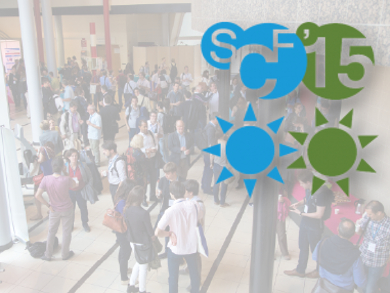For the first time since 2007, the Société Chimique de France (SCF, French Chemical Society) held a national congress (SCF’15), which took place in Lille from July 4 to 9, 2015. The conference was mainly themed around chemistry and energy, the motto was “chimie et transition énergétique”. Further topics were addressed in an overarching “Highlights of Chemistry” session.
SCF president Olivier Homolle explains: “We wanted this congress to be a symbol of the importance, responsibility, and role of chemistry in global challenges today.” The society’s secretary general Igor Tkatchenko concurs: “We therefore decided to have a focused rather than a classical, broad conference.” The congress comprised an outreach weekend, a half-day inaugural session with round-table discussions, and a three-day scientific meeting with lectures and a poster session. It was attended by around 400 scientists.
Didier Paillard, Université de Versailles-St-Quentin, France, gave a very interesting introduction on past and future of climate change, which is driven by CO2 concentration in the atmosphere rather than cosmic events. Emily Carter, Princeton University, NJ, USA, discussed contributions of quantum mechanics to sustainable energy supply: high precision is required to obtain reliable electron distributions. Orbital-free DFT is used for calculations that for example concern liquid lithium on fusion reactor walls.
 |
|
Impressions from Lille and from SCF’15. |
Jean-Marie Tarascon, Collège de France, Paris, reported on chemical contributions for electrode design, such as materials production at low energy and the design of renewable organic electrodes, and Li/S and Na/air batteries. Christophe Copéret, ETH Zurich, Switzerland, spoke about active sites in heterogeneous catalysis, such as Si-supported Re catalysts, γ-Al2O3, metathesis and polymerization, the role of Cr2+ surface species, supported nanoparticles, and characterization by 31Si and 13C NMR. Marc Fontecave, Collège de France, Paris, pointed out that energy storage techniques are still missing and elaborated on the generation of hydrogen by bioinspired catalysts and artificial enzymes.
Michael Grätzel, EPF Lausanne, Switzerland, talked about mesoporous photovoltaic systems and dye-sensitized solar cells which are produced commercially and installed for example at the EPFL congress center and EXPO at Milan. He mentioned colorants and pigments, especially metal-halide perovskites. CH3NH3PbI3 is also a very interesting material, which completely infiltrates TiO2 on which it is deposited. Christophe Rupp-Dahlem, Roquette, Lestrem, France, concluded on plant-based chemistry as a cornerstone for a bioeconomy.
Plenary lectures were complemented by flash presentations of industrial applications and collaborative institutions, e.g., RS2E (Research Network on Electrochemical Energy Storage) and IFMAS (Institut Français des Matériaux Agro-Sourcés) with BASF and CALNESIS, and funders, e.g., NFID and Energie2000, as well as a thesis on radionuclide analysis and separation. Eva Wille, Wiley-VCH, lectured on ChemPubSoc Europe and its journals; she pointed to the 20th anniversary of Chemistry – A European Journal.
Around 240 papers were presented orally or as posters in seven thematic series. Rénald David was recognized by the SCF’s solid-state division for his excellent thesis, which resulted in no fewer than three Communications in Angewandte Chemie in two years. At the end of the meeting, poster prizes were given in each thematic series to C. Marino, T. Fogeron, A. Delice, N. El Achi, L. Plais, B. Haidon, and X. Frogneux.
The organizing team led by Stanislas Pommeret and Axel Löfberg did a great job and created a communicative and cordial atmosphere. Outside the meeting, it turns out that Lille’s architecture has way more to offer than just cobblestones, and its gastronomy certainly consists of a lot more than French fries!
- Significant Reduction in NiO Band Gap Upon Formation of LixNi1−xO alloys: Applications To Solar Energy Conversion,
Nima Alidoust, Maytal Caspary Toroker, John A. Keith, Emily A. Carter,
ChemSusChem 2014, 7, 195–201.
DOI: 10.1002/cssc.201300595 - Li-S Battery Analyzed by UV/Vis in Operando Mode,
Manu U. M. Patel, Rezan Demir-Cakan, Mathieu Morcrette, Jean-Marie Tarascon, Miran Gaberscek, Robert Dominko,
ChemSusChem 2013, 6, 1177–1181.
DOI: 10.1002/cssc.201300142 - NMR Signatures of the Active Sites in Sn-β Zeolite,
Patrick Wolf, Maxence Valla, Aaron J. Rossini, Aleix Comas-Vives, Francisco Núñez-Zarur, Bernard Malaman, Anne Lesage, Lyndon Emsley, Christophe Copéret, Ive Hermans,
Angew. Chem. Int. Ed. 2014, 53, 10179–10183.
DOI: 10.1002/anie.201403905 - Silver Nanoparticles for Olefin Production: New Insights into the Mechanistic Description of Propyne Hydrogenation,
Gianvito Vilé, David Baudouin, Ioannis N. Remediakis, Christophe Copéret, Núria López, Javier Pérez-Ramírez,
ChemCatChem 2013, 5, 3750–3759.
DOI: 10.1002/cctc.201300569 - Editorial: Sustainable Chemistry for Energizing the Planet,
Marc Fontecave,
Angew. Chem. Int. Ed. 2015, 54, 6946–6947.
DOI: 10.1002/anie.201502134 - Outdoor Performance and Stability under Elevated Temperatures and Long-Term Light Soaking of Triple-Layer Mesoporous Perovskite Photovoltaics,
Xiong Li, Manuel Tschumi, Hongwei Han, Saeed Salem Babkair, Raysah Ali Alzubaydi, Azhar Ahmad Ansari, Sami S. Habib, Mohammad Khaja Nazeeruddin, Shaik M. Zakeeruddin, Michael Grätzel,
Energy Technol. 2015, 3, 551–555.
DOI: 10.1002/ente.201500045 - Reversible Topochemical Exsolution of Iron in BaFe2+2(PO4)2,
Rénald David, Houria Kabbour, Dmitry Filimonov, Marielle Huvé, Alain Pautrat, Olivier Mentré,
Angew. Chem. Int. Ed. 2014, 53, 13365–13370.
DOI: 10.1002/anie.201404476 - Two-Orbital Three-Electron Stabilizing Interaction for Direct Co2+–As3+ Bonds involving Square-Planar CoO4 in BaCoAs2O5,
Rénald David, Houria Kabbour, Alain Pautrat, Nadia Touati, Myung-Hwan Whangbo, Olivier Mentré,
Angew. Chem. Int. Ed. 2014, 53, 3111–3114.
DOI: 10.1002/anie.201311183 - A Genuine Two-Dimensional Ising Ferromagnet with Magnetically Driven Re-entrant Transition,
Houria Kabbour, Rénald David, Alain Pautrat, Hyun-Joo Koo, Myung-Hwan Whangbo, Gilles André, Olivier Mentré,
Angew. Chem. Int. Ed. 2012, 51, 11745–11749.
DOI: 10.1002/anie.201205843
Also of Interest
- Event: Congrès 2015 de la Société Chimique de France (SCF’15)
The congress focused on Chemistry and the Energy Transition - Il était une fois SCF’15 … (in French)
Event summary by the Société Chimque de France - SCF’15 on Twitter




